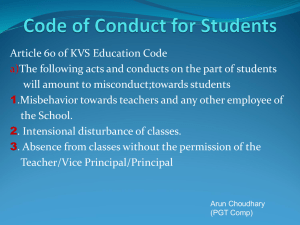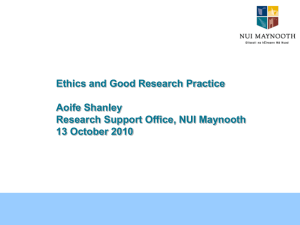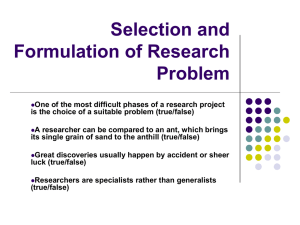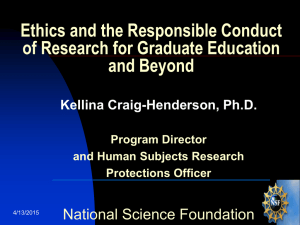Combined-UoD-Good-Scientific-Practice-and-updated
advertisement
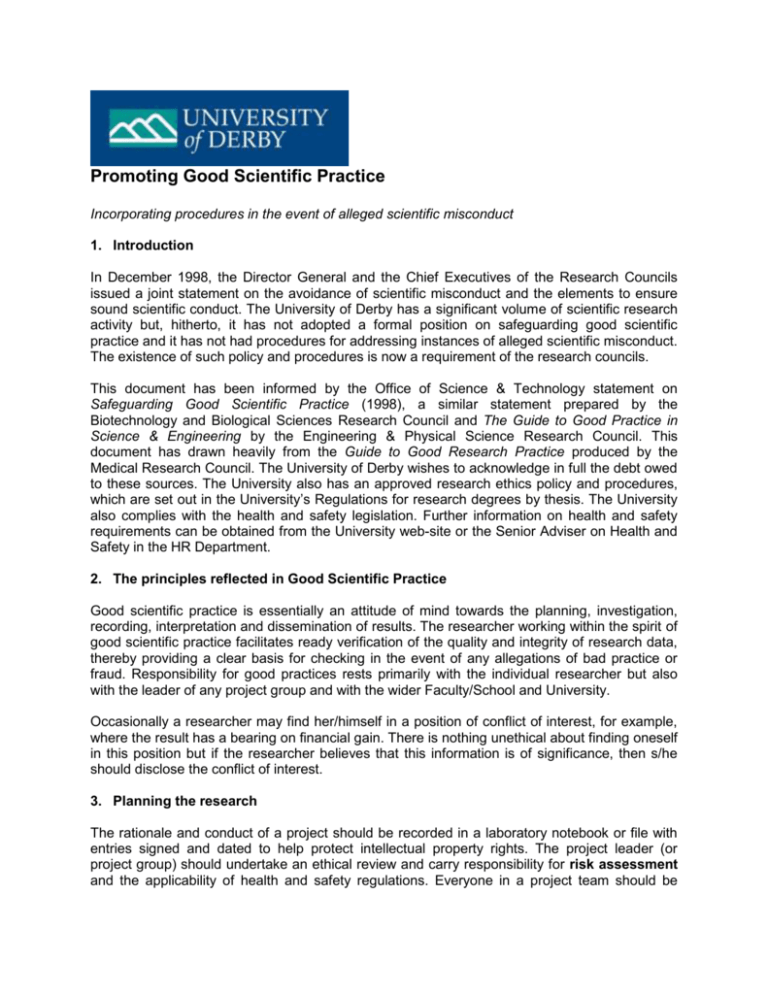
Promoting Good Scientific Practice Incorporating procedures in the event of alleged scientific misconduct 1. Introduction In December 1998, the Director General and the Chief Executives of the Research Councils issued a joint statement on the avoidance of scientific misconduct and the elements to ensure sound scientific conduct. The University of Derby has a significant volume of scientific research activity but, hitherto, it has not adopted a formal position on safeguarding good scientific practice and it has not had procedures for addressing instances of alleged scientific misconduct. The existence of such policy and procedures is now a requirement of the research councils. This document has been informed by the Office of Science & Technology statement on Safeguarding Good Scientific Practice (1998), a similar statement prepared by the Biotechnology and Biological Sciences Research Council and The Guide to Good Practice in Science & Engineering by the Engineering & Physical Science Research Council. This document has drawn heavily from the Guide to Good Research Practice produced by the Medical Research Council. The University of Derby wishes to acknowledge in full the debt owed to these sources. The University also has an approved research ethics policy and procedures, which are set out in the University’s Regulations for research degrees by thesis. The University also complies with the health and safety legislation. Further information on health and safety requirements can be obtained from the University web-site or the Senior Adviser on Health and Safety in the HR Department. 2. The principles reflected in Good Scientific Practice Good scientific practice is essentially an attitude of mind towards the planning, investigation, recording, interpretation and dissemination of results. The researcher working within the spirit of good scientific practice facilitates ready verification of the quality and integrity of research data, thereby providing a clear basis for checking in the event of any allegations of bad practice or fraud. Responsibility for good practices rests primarily with the individual researcher but also with the leader of any project group and with the wider Faculty/School and University. Occasionally a researcher may find her/himself in a position of conflict of interest, for example, where the result has a bearing on financial gain. There is nothing unethical about finding oneself in this position but if the researcher believes that this information is of significance, then s/he should disclose the conflict of interest. 3. Planning the research The rationale and conduct of a project should be recorded in a laboratory notebook or file with entries signed and dated to help protect intellectual property rights. The project leader (or project group) should undertake an ethical review and carry responsibility for risk assessment and the applicability of health and safety regulations. Everyone in a project team should be aware of the ethical issues and requirements that apply to the project. The University’s code of practice on research ethics is set out in the Regulations for the higher Degree taken by Research Thesis (September 2003 Edition). Section 10.2 in the Regulations sets out the guiding principles of non-malfeance (doing or permitting no misconduct) and beneficience (serving the interests of others). Section 10.4 in the Regulations sets out the general principles, which should be followed. Sections 10.5 and 10. 6 set out the procedures for implementation. All research that involves the recruitment of human subjects potentially gives rise to ethical issues. Therefore, if a project leader considers that there are no ethical issues, s/he should submit a brief summary of any such proposed research to the Faculty Research and Research Degrees Committee. The FRRDC will then decide whether formal ethical approval is required either by the University Research Ethics Committee or an NHS Local Research Ethics Committee and notify the project leader of its decision. In clinically-related studies an identified health professional should take responsibility for the well-being of volunteers. In the case of Clinical Trials, it is good practice for the Trials to be registered with the Department of Health Research and Development Unit and a Clinical Trial number identified. This number can then be used in all correspondence. This ensures that the Trial is uniquely identified as it progresses and assists with multi-centre or future studies. The project leader should check on resource needs and plan to undertake regular reviews of progress so that plans can be modified if necessary. It is recommended that the project team reaches agreement in advance as to who will write the planned publications. Certain items of equipment and substances used in scientific research require specific controls (eg. lasers, radiation equipment, biological materials, animals, drugs and other chemicals may have legislative requirements.) Researchers should also ensure that they are appropriately qualified, insured,/indemnified and permitted in law to employ such equipment and substances. The researcher may need to organise supervision in the use of such items. Any faculty policies with regard to such items must be complied with and appropriate individuals and bodies should be aware and consult to the activities taking place (eg radiation protection officer, Biological protection officer, the professional body.) 4. Conducting the research Equipment should be located in safe, suitable accommodation and serviced in accordance with the manufacturer’s instructions. A member of staff should be designated as responsible for the maintenance of the equipment and the supervision of other users. The operator should normally calibrate on each occasion of use. Standard operating procedures should be documented and applied to ensure the production of consistent and accurate data. The members of the project team must comply with the regulations on Control of Substances Hazardous to Health (COSHH) in line with planned action following the risk assessment at the planning stage. Decontamination and waste disposal should take place in accordance with the regulated procedures. 5. Recording data Raw (and secondary) data should be kept safely in a way that facilitates retrospective audit. All raw data should be in bound notebooks with numbered pages or an electronic notebook. Printouts, questionnaires and chart recordings should be in a separate indexed ring binder with cross-references to the notebooks. In the case of health studies consent forms should be kept with the raw data. If there are ethical issues, which have been the subject of approval by the University Research Ethics Committee or the Local NHS Research Ethics Committee, the Project Leader should keep a record of the correspondence with the records of the project. Any ethical reports should be in place before the research begins. Special attention should be paid to recording accurately the use of potentially hazardous substances. In the case of research training, it is recommended that the director of studies checks and signs off the notebooks and ring binders of raw data at intervals. Computer data should be backed up electronically with hard copies of important data. Copies of software should be kept with the raw data. If the results inform national policy making, they should be archived. Special care is needed to protect confidentiality of personal data. The Medical Research Council recommends that primary data are kept at the University for a minimum of 10 years and records relating to health studies should be retained 20 years. If researchers leave the University they must get permission of the project director to take copies of the data. They must agree that future use is consistent with the terms of consent. 6. Reporting the results The dissemination of the outcomes of research is a responsibility of paramount importance. The researcher or project team should proceed to publication as soon as any matters relating to confidentiality and ownership have been resolved. A written agreement should be negotiated with any external sponsors. The results should appear in a reputable publication normally requiring peer review. It is unethical to exaggerate results, or to not report results for the purposes of gaining unfair advantage or protecting a scientific position. In the case of a research team the project director authorises the publication of results giving due consideration to the integrity of results, adequacy of internal peer review and the protection of IPR. The published report should contain information about the ethical acceptability of the work or its legality as well as the scientific method. Any prior release of information on the internet may compromise IPR so it is recommended to give careful consideration as to whether this is desirable. Careful consideration should be given to the matter of formal authorship. The authorship should include all individuals who have made a major contribution to the work and who are familiar with the entire paper. The test for authorship is that the named individual has participated sufficiently to take public responsibility for the content. All contributors to the work should be acknowledged formally including any financial sponsors. The fragmentation of investigations into small multi-author papers in order to increase the number and volume of publications is regarded as undesirable practice. Similarly, the restructuring and editing of material for the publication of essentially the same information in different journal (sometimes referred to as shingling) is also poor practice. If an error is found that degrades the worth of published results, the principal author should discuss this with the coauthors and prepare a correction for publication as soon as possible. (See also the University’s Regulations and guidance on Intellectual Property Rights.) Procedures in the event of alleged scientific misconduct The procedures are designed to apply to current staff and students of the University of Derby. They also apply to consultants who are contracted by the University to work on investigations on behalf of the University. The procedures are only applicable in regard of misconduct, which is alleged to have occurred during the time that they have been employed (as staff) or registered (as students) by the University. The procedures do not apply to persons who are employed by other organisations, even if those individuals were engaged in collaborative research with staff of the University. The University does not have powers to investigate former employees or students who are now employed elsewhere. The University procedures will be applied in response to complaints received in writing from either internal or external persons or organisations. 1. Stage One: Preliminary action An allegation may be received by the Vice-Chancellor, a member of the Corporate Management Team or the Research Office. It is passed to the relevant Dean of the Faculty who decides, after consultation with the Pro Vice-Chancellor (Learning, Teaching and Scholarship) and the Head of Research, whether the allegation falls within the scope of the procedure and whether an assessment is warranted. The Dean informs the individual against whom the allegation is made, the substance of the allegation and invites them to respond. If s/he is not satisfied with the response or believes that the reputations on any of the parties could be at risk if the matter is not taken to the formal investigation stage, s/he will proceed to Stage Two. The Formal Investigation Panel (Stage Two) serves as the formal Disciplinary Hearing as required by the University’s disciplinary regulations. If the Dean decides that a formal investigation is warranted s/he will arrange for all relevant research records and materials to be immediately sequestered and lodged securely in the Research Office. If s/he decides that a formal investigation is not warranted, s/he records the justification for the decision and informs the complainant, the researcher(s), the Pro ViceChancellor (LTS) and the Head of Research. If the allegation relates to a perceived risk to health or safety, then the Dean must take action to be sure that any such risk is eliminated. 2. Stage Two: The Formal Investigation: a Disciplinary Hearing The purpose of the formal investigation is to make a thorough evaluation of all the relevant facts to determine whether there has been misconduct. If it is decided that misconduct has been committed, then it is necessary to decide who was responsible and the seriousness of the incident. The Dean appoints a Misconduct Investigation Panel comprising three appropriately qualified persons. The first member should hold a senior research position within the Faculty and should normally be designated Chair. A second member should have research experience relevant to the case. The third member of the Panel should be external to the school/ department or the University. None of the members of the Investigation Panel should have any conflict of interest with the case. They must have the expertise necessary to interview the witnesses. The Dean notifies the researcher(s) of the composition of the Misconduct Investigation Panel and gives opportunity for a written objection. The Dean must record the reasons for accepting or rejecting any objection raised. The investigation should normally include examination of all documentation including relevant research data materials, proposals, publications, correspondence, memoranda and notes of telephone calls. The researcher(s) is entitled to be present during the receipt of all evidence from the complainant and the witnesses. S/he should be in receipt of all written evidence being used as evidence by the Misconduct Investigation Panel and s/he may also ask questions of clarification with regard to this evidence through the Chair. The secretariat should keep a detailed record of the hearing including a verbatim documentation of the spoken evidence. The final report should be completed within ten weeks of the written notification to the researcher(s) that the matter is to considered by a Misconduct Investigation Panel. The final report should state how the investigation was conducted, how the information was obtained, set out the findings, explain the basis for the findings and include an accurate agreed summary of the views of the researcher(s) alleged to have engaged in misconduct. The researcher(s) will be given an opportunity to comment on the report. . The researcher(s) will be given 3 weeks to prepare a written response statement following receipt of the report. This response should be attached as an addendum to the report. If the researcher(s) decides to challenges any part of the report, s/he may request a meeting with the Dean and the Chair of the Misconduct Investigation Panel. The researcher should be quite clear about any statements, which s/he believes are unsubstantiated. The final decision rests with the Dean of Faculty who may consult the Pro Vice-Chancellor (LTS) and Head of Research. If the Misconduct Investigation Panel finds that misconduct was committed and the researcher(s) were responsible, it will be the responsibility of the Dean to decide on the appropriate action. This should reflect the seriousness of the infringement/offence as advised by the Misconduct Investigation Panel. 3. Notification of the final decision The Dean will write to the researcher(s), complainant, the Chair of the Misconduct Investigation Panel, the Pro Vice-Chancellor (LTS) and Head of Research to inform them of the final decision. S/he will also recommend any amendment to the aspects of the Promoting Good Research Practice document or this Procedures in the event of alleged Misconduct in Research which may be appropriate. 4. Sanctions If the allegations of misconduct in research have been substantiated then the Dean shall determine the appropriate sanctions. These may be one or more of the following: Removal from a particular project (staff or student) A final written warning (staff or student) Special monitoring of work (staff or student) Removal of eligibility for pay progression for one year/or loss of increment (staff) Loss of funding/access to future funding (staff) If the Dean decides that the nature of the misconduct is very serious indeed and has brought the school or institution into disrepute, s/he may recommend to the Pro Vice-Chancellor (LTS) that the person concerned should have their employment/registration terminated. If the recommendation is agreed, this is conveyed the Vice-Chancellor who may dismiss the person without further notice. In the event of a registered health or social care professional, or scientist regulated by the code of conduct of a professional body, the Dean should notify the appropriate registering/regulatory body of the outcome of any case where the researcher(s) have been found guilty of misconduct. This may trigger a separate disciplinary procedure of the regulatory body with regard to the fitness for practice of the researcher(s) concerned. This is very important. Failure to report might be deemed as placing the public at risk through continued bad practice. If the regulatory body decides to strike off the researcher(s) then the University may be obliged to dismiss or redeploy the researcher(s). In the case of a student, the regulatory body may not be willing to register the student or may decide to terminate registration. 5. Appeal If the researcher(s) wish to appeal against the decision of the Dean, then s/he should submit the appeal within two weeks of the final written notification by the Dean. The Appeal procedure, operates in accordance with normal procedures for the consideration of Appeals against the findings of disciplinary hearings (staff or students as appropriate) at the University. The outcome of the Appeal process is final. The Vice-Chancellor will notify the researcher(s) of the final decision. If at any time the researcher(s) decides to accept the substance of the allegations, it will be for the Dean of the Faculty, in consultation with the Pro Vice Chancellor (LTS) and the Head of Research, to identify an appropriate sanction. This sanction should be mutually satisfactory to the complainant and the researcher(s) concerned. S/he will also need to take into consideration any damage which has been caused to the Faculty/University’s reputation and the extent to which the admission and agreement has mitigated such damage. If the researcher(s) is found not guilty of the allegations, the Faculty and University will take all reasonable steps to restore the reputation of the researcher(s) concerned. Acknowledgements: Dr Peter Rivers and Dr Warren Turner (SEHS) are acknowledged for their very helpful detailed comments on the original proposals (2004). There were no allegations of misconduct in research at the University between 2004 and 2009. This revised edition (March 2009) has been informed by and is consistent with the Procedure for the Investigation of Misconduct in Research published by the UK Research Integrity Office, August 2008. PHB/ Original procedures approved by the University of Derby Academic Board, 31 st March 2004 Nomenclature updated October 2006. Revised edition agreed by the University Research and Research Degrees Committee: 25 th March 2009 Approved by Academic Board: Date 8th July 2009
